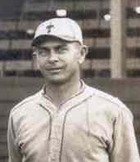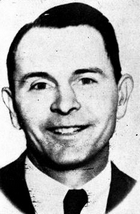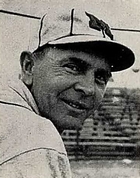Roswell Higginbotham
| Date and Place of Birth: | August 15, 1898 Jamison, TX |
| Date and Place of Death: | May 23, 1943 Quonset Point Naval Air Station, RI |
| Baseball Experience: | Minor League |
| Position: | Infield |
| Rank: | Lieutenant (jg) |
| Military Unit: | US Navy |
| Area Served: | United States |
"Higginbotham, star athlete of Texas A & M college, back in
the early 1920s, died from complications following an abdominal
operation."
Port Arthur News May 30, 1943
Roswell G. Higginbotham, known as “Little Hig,” first gained
prominence as an outstanding backfield football player at Sherman High
School, Texas, and went on to become a renowned football and baseball
player at Texas A&M from 1917 to 1920. In his junior year, he pitched a
no-hitter against the University of Texas, and was a football
All-Southwest Conference back in 1919 and 1920.
Following in the footsteps of his brother Graly, Higginbotham left Texas
A&M in 1920 to start a career in professional baseball.1 He was signed
by the St. Louis Cardinals and attended spring training in 1921 at
Orange, Texas, before being assigned to the Paris Snappers of the Class
D Texas-Oklahoma League. Batting in the number two spot for fiery
manager Earl “Red” Snapp, the young second baseman hit .301 and led the
league with 53 stolen bases.
Higginbotham was back with the Snappers in 1922, and his brother Graly
was in the same league as player/manager with the Sherman Red Sox.
Higginbotham, who played shortstop that year, batted .315 in 96 games,
leading the league with 36 doubles, as the Snappers clinched their
second successive league title in a season that ended August 6, due to a
railroad strike. One advantage of the early season finish was that
Higginbotham was called up by the Fort Worth Panthers of the Class A
Texas League. On August 25, 1922, he made his first appearance for the
Panthers, playing shortstop and going hitless in two trips to the plate.
He played one more game before the end of the season.
Higginbotham, however, turned his back on professional baseball after
1922. It was a time when there was often more money to be made with
semi-pro teams, and he played with Thurber of the West Texas Oil Belt
League during the summer, while coaching football at Austin College in
the winter and baseball in the spring. In 1927, he accepted a position as freshman athletic coach
at Texas A&M, and in 1928, aged 29, he made a surprising return to
professional baseball. Red Snapp — his manager at Paris back in 1922 —
was manager and part-owner of the San Angelo Red Snappers of the
newly-formed Class D West Texas League, and encouraged Higginbotham to
join the club. Batting in his familiar number two spot, but playing the
outfield rather than the infield, he played 81 games and hit .286 with
10 home runs as the Red Snappers clinched the league title. They went on
to defeat the Abilene Aces, three games to two, in the playoffs, before
stumbling against the Palestine Pals of the Lone Star League in a dual
championship playoff series. On September 2—in a game against the Pals
that was to be one of Higginbotham’s last games in professional baseball
— he hit three singles.
Higginbotham continued to coach freshman football and varsity baseball
at Texas A&M, and produced two championship baseball teams including the
school’s first ever Southwest Conference title in 1931, and another in
1934. In 1936, Southern Methodist University in Dallas began playing
baseball again, after having dropped the sport during the early
Depression years, and Higginbotham was hired to coach the team as well
as the freshman football team.
He remained at Southern Methodist until April 1943, when, at the age of
44, he enlisted in the Navy. Lieutenant Junior Grade Higginbotham was
stationed at Quonset Point Naval Air Station in Rhode Island, but two
weeks after his arrival he underwent an emergency abdominal operation at
the naval hospital. Higginbotham never recovered from the surgery. He
died on May 23, 1943 and is buried at West Hill Cemetery in Sherman,
Texas.
“I have met many of his former Southern Methodist players,” said his
grandson Scott Higginbotham, “and have heard nothing but great things.
They tell me he was strict, and extremely fair. All had the highest
respect. I would have loved to have known him.”
Roswell Higginbotham was buried in Sherman, Texas, and survived by his
wife, Margaret, and their son, Bobby. In 1973, he was
elected to the Texas A&M Athletic Hall of Fame.
|
Year |
Team |
League |
Class |
G |
AB |
R |
H |
2B |
3B |
HR |
RBI |
AVG |
|
1921 |
Paris | Texas-Oklahoma | D | 129 | 462 | 101 | 139 | 33 | 3 | 1 | - | .301 |
|
1922 |
Paris | Texas-Oklahoma | D | 96 | 359 | 87 | 113 | 36 | 2 | 4 | - | .315 |
| 1922 | Fort Worth | Texas | A | 3 | 9 | 0 | 4 | 0 | 0 | 0 | 1 | .444 |
| 1923 to 1927 | Did Not Play | |||||||||||
| 1928 | San Angelo | West Texas | D | 81 | 322 | 76 | 92 | 18 | 6 | 10 | - | .286 |

Roswell Higginbotham with the 1920 Texas A&M Aggies team (Higginbotham is back row, far right)

The 1921 St. Louis Cardinals at spring training (Higginbotham is middle row, fourth from right)

Thanks to the Higginbotham family, David L. Chapman, University Archivist and Associate Director, Cushing Memorial Library and Archives, Texas A&M University and to Davis O Barker for help with this biography. Thanks also to Astrid van Erp for help with photos for this biography
Date Added January 31, 2012 Updated August 2, 2017
Baseball's Greatest Sacrifice is associated with Baseball Almanac
Baseball's Greatest Sacrifice is proud to be sponsored by





